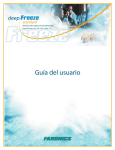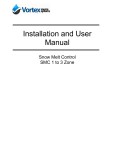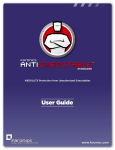Download Power Save Mac User Guide - IT
Transcript
/CB=;/B323\S`Ug1]\aS`dObW]\ This page intentionally left blank Power Save Mac Technical Support Every effort has been made to design this software for ease of use and to be problem free. If problems are encountered, contact Technical Support: Email: [email protected] Phone: 800-943-6422 or 604-637-3333 Hours: 7:00 am to 5:00pm (Pacific Time) Contact Information Web: www.faronics.com Email: [email protected] Phone: 800-943-6422 or 604-637-3333 Fax: 800-943-6488 or 604-637-8188 Hours: 7:00 am to 5:00pm (Pacific Time) Address: Faronics Technologies USA Inc. Suite 170 – 2411 Old Crow Canyon Road San Ramon, CA 94583 USA Faronics Corporation 620 - 609 Granville St. Vancouver, BC V7Y 1G5 Canada Last modified: January, 2007 © 2007 Faronics Corporation. All rights reserved. Deep Freeze, Deep Freeze Mac, Faronics, Faronics Anti-Executable, Faronics System Profiler, FreezeX, Faronics Power Save Mac, and WINSelect are trademarks and/or registered trademarks of Faronics Corporation. All other company and product names are trademarks of their respective owners. This page intentionally left blank Contents Power Save Mac Overview..................................................................................................................................7 About Power Save Mac...................................................................................................................................................7 About Apple Remote Desktop (ARD)..........................................................................................................................7 Command Line Control Capability..............................................................................................................................7 System Requirements......................................................................................................................................................7 About Faronics.................................................................................................................................................................7 Installing Power Save Mac..................................................................................................................................8 Installing Using a Customized Power Save Mac Installer..........................................................................................8 Installing Using the Basic Power Save Mac Installer...................................................................................................8 Installing via Apple Remote Desktop............................................................................................................................8 Installing Over Previous Versions.................................................................................................................................8 Uninstalling Power Save Mac.............................................................................................................................8 Using the Power Save Mac Preference Pane.......................................................................................................9 Creating a User................................................................................................................................................................9 Editing User Properties.................................................................................................................................................10 Enabling or Disabling Power Save...............................................................................................................................10 Inactivity Tab..................................................................................................................................................................10 Inactivity Definitions Tab.............................................................................................................................................11 Schedule Tab...................................................................................................................................................................12 Creating or Modifying a Scheduled Action..........................................................................................................12 Deleting a Scheduled Action..................................................................................................................................13 Shutdown Options Tab.................................................................................................................................................13 Deep Freeze Tab.............................................................................................................................................................14 Appendix I: Power Save Mac Assistant & Customizing the Installer..............................................................15 Appendix II: Apple Remote Desktop v.3.0 Integration Tasks..........................................................................19 Adding Targeted Computers to the Task List............................................................................................................21 ARD Sample Output.....................................................................................................................................................22 Sample Command Line Script.....................................................................................................................................22 This page intentionally left blank Power Save Mac Overview About Power Save Mac Power Save Mac is a preference pane that enhances and extends the Energy Saver found within the Mac OS X System Preferences. It can schedule logouts, shutdowns, restarts, and startups by day, weekend, weekday, or a specific date. Power Save Mac offers flexible options for determining when a computer is inactive (by CPU usage, network usage, hard drive usage, or by running applications—not just keyboard and mouse movement), and only shuts computers down when they are inactive for a specified amount of time. Administrators can utilize Power Save Mac to save on energy costs associated with running a multiple workstation environment. About Apple Remote Desktop (ARD) Apple Remote Desktop is Apple Computer’s complete desktop management solution for Mac OS X. Faronics does not provide sales or technical support information for Apple Remote Desktop. More information regarding ARD can be found at http://www.apple.com/remotedesktop. Command Line Control Capability Tasks referred to in Appendix II for use with ARD can also be used in other third-party command line control programs. System Requirements Power Save Mac requires Mac OS X v10.3.0 and up. Power Save Mac is a Universal application (Intel and PPC compatible). ARD integration requires Apple Remote Desktop version 2.2 or later. A minimum of 256 MB RAM is recommended. About Faronics Faronics delivers innovative solutions that help manage, simplify, and secure complex IT environments. Our products ensure 100% workstation availability, and have dramatically impacted the day-to-day lives of thousands of information technology professionals. Fueled by a customer-centric focus, Faronics’ technology innovations benefit educational institutions, healthcare facilities, libraries, government organizations and corporations. Faronics’ award-winning Deep Freeze preserves computer configurations, providing total system consistency while allowing users complete, unrestricted workstation access. Faronics Anti-Executable prevents unauthorized software from being installed or run, and Power Save lowers energy costs with intelligent energy management. Incorporated in 1996, Faronics has an office in the USA and Canada. Installing Power Save Mac Installation and configuration of Power Save Mac requires administrative access. Power Save Mac is distributed on a CD-ROM in a media package, or as a downloadable file via the Internet. Installing Using a Customized Power Save Mac Installer A customized Power Save Mac Installer can be created using the Power Save Mac Assistant. Refer to Appendix I for more information. Installing Using the Basic Power Save Mac Installer To install Power Save Mac on a single computer, complete the following steps: 1. Double-click the file Power Save.pkg to begin the installation process. (Depending on the configuration, the file extension may not be visible.) 2. Follow the steps presented, and read and accept the license agreement. 3. Click Install and Power Save Mac is installed on the computer as a preference pane accessible in System Preferences. The computer requires a restart to complete the installation. Installing via Apple Remote Desktop Power Save Mac is distributed as a standard installation package file and can therefore be installed over a network using Apple Remote Desktop’s Install Packages command. Refer to the Apple Remote Desktop user guide for more information. Refer to Appendix II for more information about controlling Power Save over a network using Apple Remote Desktop. Installing Over Previous Versions It is recommended that previous versions of Power Save Mac be uninstalled before installing a newer version, though this is not necessary. Uninstalling Power Save Mac To uninstall Power Save Mac, click the icon and select Uninstall from the action menu. Follow the steps presented; a restart is required to complete the uninstall process. If Power Save Mac is installed on a machine with Deep Freeze, the machine must be in a Thawed state for the uninstall to be successful. Using the Power Save Mac Preference Pane To launch the Power Save Mac preference pane, open System Preferences and click the Power Save icon listed under Other, as shown: The first time Power Save Mac is run, the Inactivity tab appears. To perform any action in Power Save Mac, click the lock icon to unlock the preference pane. When the changes are complete, click the icon again to lock the screen and prevent any other changes. Creating a User When the lock is clicked for the first time, the following dialog appears: Enter a User Name and Password, verify the password, and click OK. Editing User Properties To edit the properties of a user after they have been set, click the icon in the main screen and select Edit User from the action menu. Enter the new User Name and/or Password and click OK. Enabling or Disabling Power Save Check Enable Power Save in the header of any tab to enable Power Save’s functionality. Uncheck Enable Power Save to disable Power Save. Inactivity Tab The Inactivity tab is used to configure what action (sleep or shutdown) will occur for what length of time when a workstation becomes inactive, and appears as follows: To manage energy used by the computer’s CPU, and put the computer into Sleep mode when inactive, use the appropriate slider bar and adjust the number of minutes to initiate the Sleep function. To manage energy used by the computer’s display, and put the display into Sleep mode when the computer is inactive, use the appropriate slider bar and adjust the number of minutes to initiate the Display Sleep function. To manage energy used by the computer’s hard disk, check the Put the hard disk(s) to sleep when possible checkbox. To save energy used by the computer’s CPU, and shut the computer down when inactive, check the Shut down after xx minutes of inactivity checkbox and use the spin box to choose the number of minutes for this action to occur. The user can always cancel any action by moving the mouse or using the keyboard. 10 Inactivity Definitions Tab The Inactivity Definitions tab is used to define when a workstation is inactive. The basic definition that Power Save uses to define inactivity is stated at the top of the tab: the mouse and/or keyboard are not being used. The other options are in addition to this definition. By default, the four configurable options are not checked (unless pre-set via the Power Save Assistant). If no configuration is done to this tab, the only element of inactivity will be keyboard and mouse movement. To include CPU activity in the inactivity definition, check CPU Usage and use the slider bar to configure the percentage of CPU usage which defines inactivity. To include network activity in the inactivity definition, check Network Usage and use the slider bar to configure the amount of network traffic (in kb/s) which defines inactivity. To include hard disk activity in the inactivity definition, check Hard Drive Usage and use the slider bar to configure the amount of hard disk traffic (in kb/s) which defines inactivity. For all of the above inactivity definitions, the program will check for activity every 30 seconds to determine if the utilization is below the designated amount. To include the activity of running applications in the inactivity definitions, check Auto-cancel actions if any of these programs are active. If any of the applications which are added to this list are running, the computer is considered active and shutdown/sleep actions will not occur. To add an individual application to the list, click the icon, browse to the location of the desired program, and click Choose. The application is then added to the list. To remove an application from the list, select it and click the icon. 11 Schedule Tab The Schedule tab is used to customize scheduled energy management tasks. All scheduled actions appear in the scheduled action window as shown below: Uncheck the corresponding checkbox under the Active column to render any scheduled action inactive. Check Cancel scheduled sleep and shutdown actions if the computer is active to prevent scheduled actions from occuring if the computer is active (in accordance with the designated Inactivity Definitions). Creating or Modifying a Scheduled Action To add a scheduled action, click the icon and choose the type of action required. The following configuration screen appears: configuration screen appears: From the Frequency drop-down menu, select if this action will repeat or is a one-time only action. For Repeating actions, choose from the available options: 12 Item Options Action Schedule choose from the following action items: Start Up, Shut Down, Wake, or Sleep choose from the following schedule: Every Day, Weekdays, Weekends, or a single specified day of the week choose a specific time of day for the action to occur Time For Once actions, choose from the available options: Item Options Action Date choose from the following action items: Start Up, Shut Down, Wake, or Sleep enter a date and time at which the action will occur Once the action has been configured, click OK to save the action and return to the Schedule tab. Click Cancel at any time to cancel adding or modifying the action and return to the Schedule tab. To modify an existing action, double-click it in the list. Deleting a Scheduled Action To delete a scheduled action, select the action in the list and click the icon. Multiple actions can be selected by command-clicking the desired actions or shift-clicking a continuous group of actions. A dialog appears confirming that the selected actions are to be deleted. Click Delete to permanently remove the action, or click Cancel to return to the Schedule tab. Shutdown Options Tab The Shutdown Options tab is used to customize various options that affect shutdown. 13 To warn users before a pending shutdown, check the Warn users checkbox and choose to have the warning appear either 5, 10 or 15 minutes before shutdown. To allow users to cancel pending shutdowns, check the Allow user to cancel shutdown checkbox. To automatically cancel shutdowns if multiple users are logged into a computer, check the Auto-cancel shutdown if multiple users logged in checkbox. Deep Freeze Tab The Deep Freeze tab is used to ensure compatibility with Deep Freeze Maintenance Periods. If Power Save Mac is installed on a computer which is also running Deep Freeze, Power Save will automatically inform the user if configurations changes are attempted while the computer is Frozen. The possibility also exists that Power Save may shutdown a machine prior to a Deep Freeze scheduled maintenance window. To ensure that these maintenance periods run as scheduled, Power Save is able to detect the time of the Deep Freeze maintenance window and will automatically schedule a “start-up” action 15 minutes prior to its occurrence. If Deep Freeze is installed and is configured with a scheduled a maintenance window, check the Make sure workstation is running before Deep Freeze Maintenance checkbox. If Deep Freeze is not installed, or if a Deep Freeze maintenance schedule is not configured, this option can be left unchecked. 14 Appendix I: Power Save Mac Assistant & Customizing the Installer Power Save Mac Assistant can be used to create customized Power Save Mac installation packages and allows you to create global settings for a multiple workstation environment. Power Save Mac Assistant can also directly install Power Save Mac specific Saved Tasks into the Apple Remote Desktop (ARD) console on the current system. ARD tasks are not part of the customized Power Save Mac installation package. Neither ARD nor the ARD agent can be running in order for the task installation to be successful. To run Power Save Mac Assistant, complete the following steps: 1. Double-click the program icon to open Power Save Assistant. The Introduction screen appears: 2. Click Continue. The Power Save Tasks screen appears: 15 If ARD tasks were installed with a previous version of Power Save Mac, these tasks must be deleted prior to installing the tasks for Power Save Mac 1.5; previous tasks are not overwritten. 3. Check the box marked Yes, Install Tasks if you want the Power Save Mac specific tasks to be exported into ARD on the current machine. A dialog may appear, stating that ARD or the ARD agent is currently running and giving the option to quit ARD immediately or at a later time. The Power Save tasks will only be installed if ARD is not running. Choose the preferred action, and click Continue. The Power Save Mac Custom Installer screen appears: 4. To create a custom client installer, check Yes, create a custom installer and click Continue. The Power Save Administrator screen appears: 16 5. Enter the User Name and Password of the Power Save Administrator to be created by the custom installer and used by Power Save Mac’s Apple Remote Desktop tasks. Retype the password to verify it and click Continue. 6. The remaining screens provide options to pre-configure all settings for the Inactivity, Inactivity Definitions, Schedule, Shutdown Options, and Deep Freeze tabs. Refer to those respective sections in this user guide for more information. 7. Once Configuration is complete, the Choose Power Save Mac Installer screen appears: 8. Click Choose and browse to the location of the Power Save Mac installer package (Power Save.pkg) located in the Power Save Mac folder. Alternatively, drag and drop the package file into the Choose dialog screen. Click Continue. The Where to Save screen appears. 17 9. Click Choose. A standard Save dialog appears. Browse to a location to save the custom client installer and select it. Alternatively, drag and drop the preferred save location into the Choose dialog screen. Click Continue. The final screen appears, stating that the custom client installer was successfully created and that the Power Save Mac tasks were installed into ARD. 10. Click Quit to close the Power Save Mac Assistant. 18 Appendix II: Apple Remote Desktop v.3.0 Integration Tasks Power Save Mac Assistant can install Saved Tasks for use with Apple Remote Desktop. These tasks can be used as supplied or as a starting point for controlling Power Save Mac with ARD. The functions of each task are described below. Each task can be configured in the Power Save Mac preference pane, except for requestStatus. The requestStatus command returns the same information found in the main page of the Power Save user interface. Task Function addAppToList Adds a new application to the auto-cancel list under Inactivity Definitions on the target computer(s) addEventOnce Adds a one-time event on a specified date addEventRepeating Adds an event that repeats on a specified basis addUser Creates a Power Save user on the target computer(s) allowUsersToCancelActions Allows user to cancel an impending shutdown on the target computer(s) autoCancelActionsIfMultipleUsers Automatically cancels an impending shutdown if multiple users are logged into the target computer(s) autoCancelActionsIfSetAppsOpen Automatically cancels an impending action if specific applications have been designated on the target computer(s) CancelScheduledEventsIfComputerActive Automatically cancels an impending scheduled action if the target computer(s) is active (as set in Inactivity Definitions) checkForUpdates Checks whether the present version of Power Save on the target computer(s) is the most current 19 20 CPUAutoCancelIfAboveThreshold Automatically cancels an impending action if CPU activity is above the designated level on the target computer(s) CPUSleep Automatically puts the CPU on the target computer(s) to sleep after the designated amount of minutes disable Disables Power Save on target computer(s) displaySleep Automatically puts the computer display on the target computer(s) to sleep after the designated amount of minutes dontAllowUsersToCancelActions Users cannot cancel an impending shutdown on the target computer(s) dontAutoCancelActionsIfMultipleUsers Allows shutdowns to occur if multiple users are logged into the target computer(s) dontAutoCancelActionsIfSetAppsOpen Allows an impending action to occur even if specific applications have been designated on the target computer(s) dontCancelScheduledEventsIfComputerActive Allows an impending scheduled action to occur even if the target computer(s) is active (as set in Inactivity Definitions) dontHDAutoCancelActionsIfAboveThreshold Allows an impending action to occur even if hard disk activity is above the designated level on the target computer(s) dontCPUAutoCancelIfAboveThreshold Allows an impending action to occur even if CPU activity is above the designated level on the target computer(s) dontHDAutoCancelActionsIfAboveThreshold Allows an impending action to occur even if hard disk activity is above the designated level on the target computer(s) dontHDSleepIfPossible Turns off automatic hard disk sleep on the target computer(s) dontNetworkAutoCancelActionsIfAboveThreshold Allows an impending action to occur even if network activity is above the designated level on the target computer(s) dontShutdownAfter Turns off inactivity shutdowns on target computer(s) dontWarnUsersBeforeAction Turns off user warnings before impending actions on the target computer(s) editUser Makes changes to a Power Save user’s username and password on the target computer(s) enable Enables Power Save on target computer(s) HDAutoCancelActionsIfAboveThreshold Automatically cancels an impending action if hard disk activity is above the designated level on the target computer(s) HDSleepIfPossible Automatically puts the hard disk on the target computer(s) to sleep when possible networkAutoCancelActionsIfAboveThreshold Automatically cancels an impending action if network activity is above the designated level on the target computer(s) removeAppFromList Removes a designated application from the auto-cancel list on the target computer(s) removeEvent Removes a designated Power Save event on the target computer(s) requestStatus Requests target computer(s) to display the status of various Power Save settings on the target computer(s) shutdownAfter30 Shuts down target computer(s) after 30 minutes of inactivity (this value is customizable) uninstall Uninstalls Power computer(s) version Requests Power Save version number on the target computer(s) warnUsersBeforeAction Warns users a designated amount of time before impending actions are to occur on the target computer(s) Save on the target Adding Targeted Computers to the Task List In order to run a task, there must be computers targeted to run the task. To add one or more computers to be targeted to run the task, complete the following steps: 1. 2. 3. 4. In the left column, double-click the task to be targeted to the specified computers. The Task Edit window appears. At the bottom of the window is a dialog listing the designated computers assigned to the task. Before a computer is added to the list, it reads No Computers. Drag and drop the preferred workstations or group of workstations into the dialog from the computers in the All Computers list. The number of computers assigned to a specific task appears at the bottom of the window. Click Save. The following figure shows the enable task set to run: 21 Each task must be edited to use a Power Save user name and password for the target computer(s). In the above example, admin is the Power Save user name and admin is the Power Save password. The name and password may already be present in the task, depending on the settings that were specified in Power Save Assistant. ARD Sample Output The following figure shows the sample output from the requestStatus function. The Display all output checkbox must be selected in the Apple Remote Desktop Edit Task window in order to show the target’s status. Sample Command Line Script The Power Save Mac tasks give network administrators increased flexibility when managing energy usage on Power Save Mac workstations. These tasks can be run with several different third-party enterprise management tools and/or central management solutions; this includes executing commands in Terminal while connected to a remote workstation via SSH. A sample script using the shutdownAfter30 command is shown below: Library/Application\Support/Faronics/PowerSave/CLI administrator password shutdownAfter 30 In this example, administrator is the name of a valid Power Save Mac user and password is that user’s password; the number 30 is customizable to the preferred length of time. The sample script can be modified to run any task listed in the Task table. 22
































